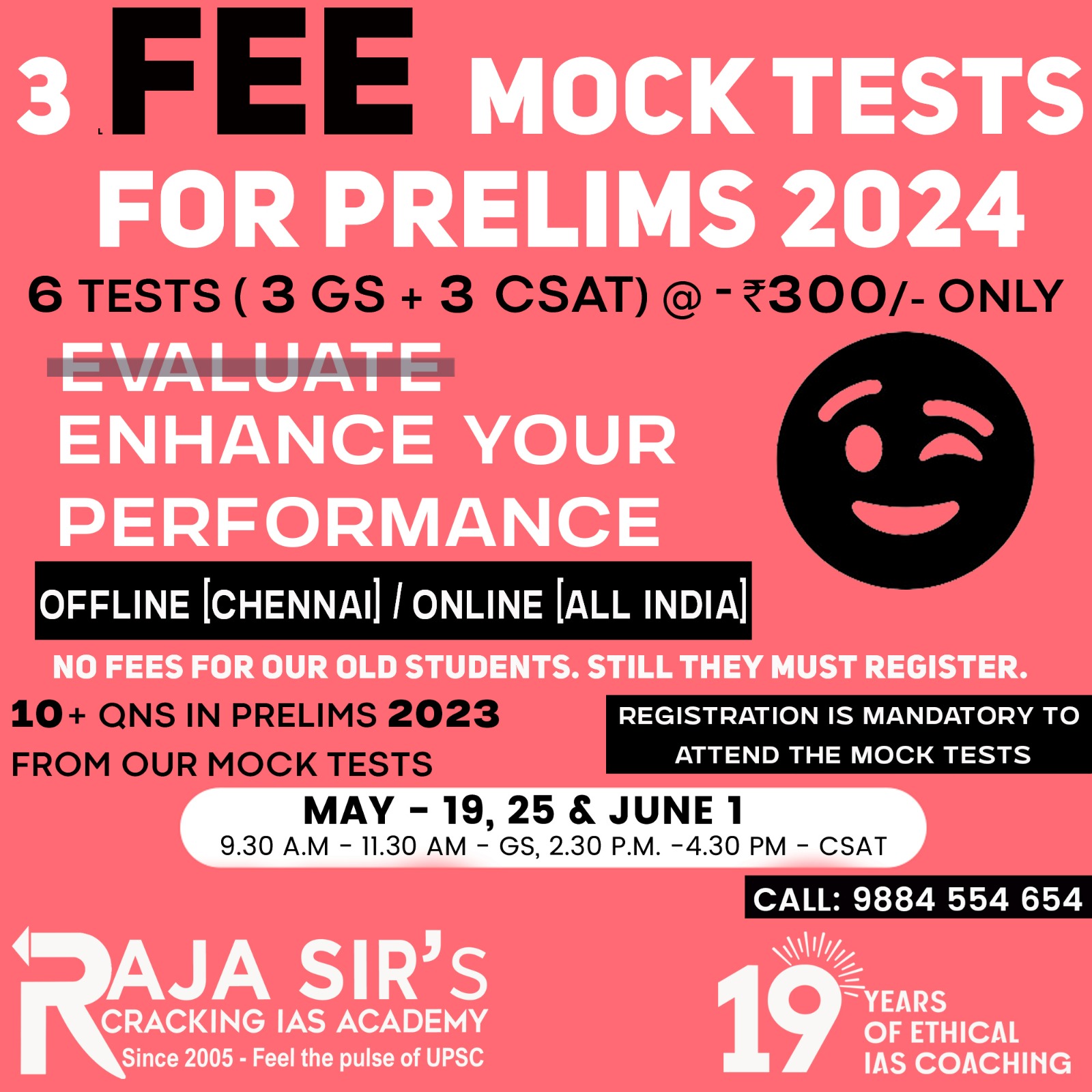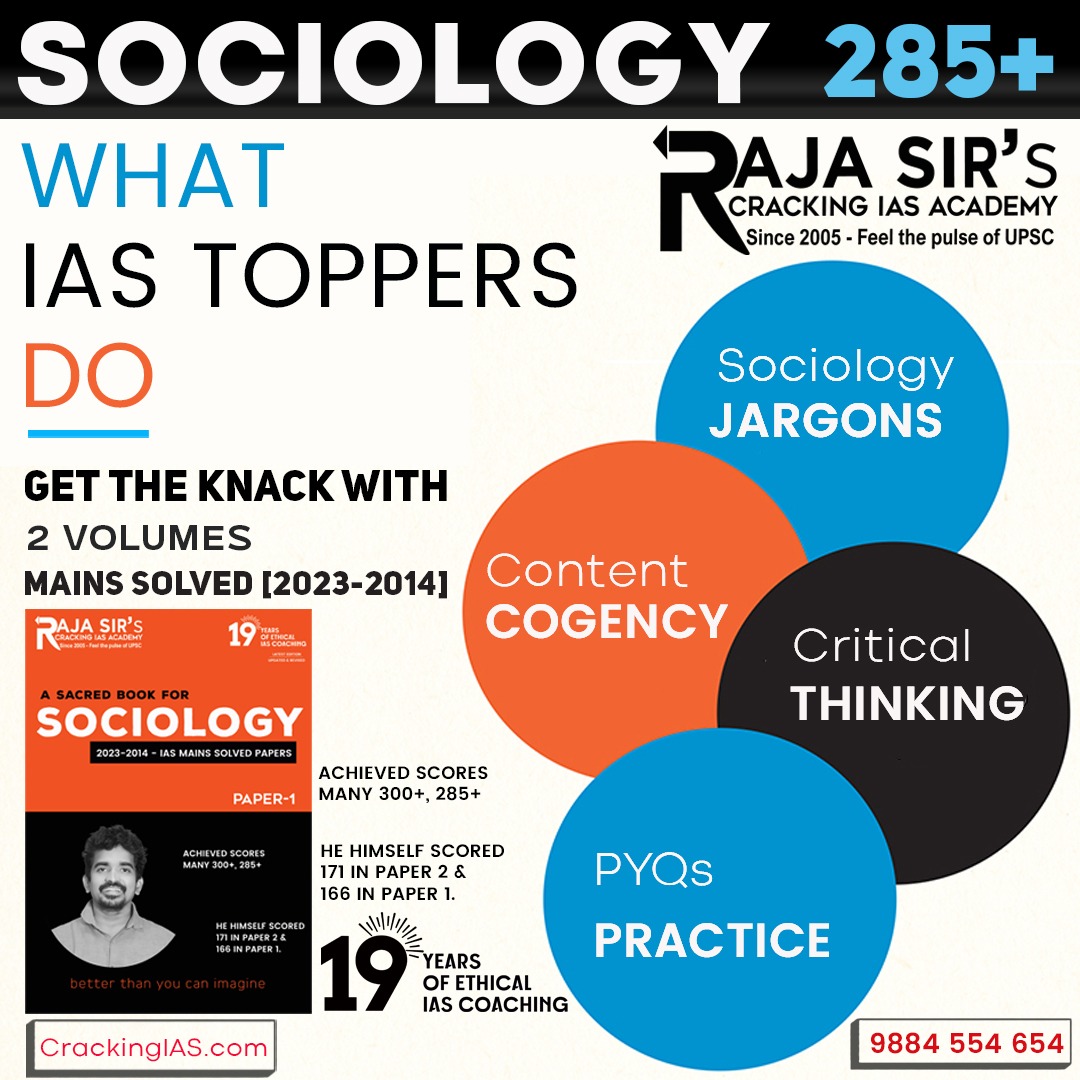- Home
- Prelims
- Mains
- Current Affairs
- Study Materials
- Test Series
Hit List Questions 29 - PPP 100 PRELIMS 2024 - 47
Questions & Explanations:
|
1. |
“5Fs” crisis in news refer to the context of (a) Finance sector (b) South China Sea dispute (c) Refugees issue (d) Healthy diet
|
|
|
2. |
“Sirturo” patent battle in India rfers to the context of the disease (a) Tuberculosis (b) Malaria (c) Blood cancer (d) hepatitis
|
|
|
3. |
1. It is an executive body. 2. It has been designated as the agency to monitor provisions of the Right to Free and Compulsory Education (RTE) Act. Which of the statements given above is/are correct w.r.t. National Commission for Protection of Child Rights (NCPCR):? (a) 1 only (b) 2 only (c) Both 1 and 2 (d) Neither 1 nor 2
|
|
|
4. |
1. Pompe disease is caused by Tapeworms. 2. Enzyme Replacement Therapy is used to treat Pompe disease. (a) Only 1 is true. (b) Only 2 is true. (c) 1 & 2 are true (d) Neither 1 nor 2 is true |
|
|
5. |
A company marketing food product advertises that its items do not contain trans-fats. What does this campaign signify to the customers? 1. The food products are not made out of hydrogenated oils. 2. The food products are not made out of animal fats/ oils. 3. The food products raise low-density lipoprotein levels in the blood. Which of the statements given above is/are correct? (a) 1 only (b) 2 and 3 only (c) 1 and 3 only (d) 1, 2 and 3
|
|
|
6. |
Carbapenems are a class of (a) Antibiotics (b) Viral Vectors (c) Corals (d) Fishes
|
|
|
7. |
Consider the following statements w.r.t. Birsa Munda: 1. He led ''The Great Tumult Movement''. 2. He stood up against the Christian missionaries. Which of these statements is/are correct? (a) 1 only (b) 2 only (c) Both 1 and 2 (d) Neither 1 nor 2
|
|
|
8. |
Consider the following statements: 1. According to the Indian Patents Act, a biological process to create a seed can be patented in India. 2. In India, there is no Intellectual Property Appellate Board. 3. Plant varieties are not eligible to be patented in India. Which of the statements given above is/are correct?. (a) 1 and 3 only (b) 2 and 3 only (c) 3 only (d) 1, 2 and 3 o |
|
|
9. |
Consider the following w.r.t. Sickle cell anaemia: 1. It is a genetic blood disorder. 2. It is concerned with the leucocytes. 3. It is prevalent in communities residing in areas where malaria is endemic. Which of these is/are correct?. (a) 1 only (b) 3 only (c) 1 and 3 only (d) 1, 2, 3
|
|
|
10. |
He was an Italian Jesuit missionary and Tamil scholar. He dressed like a Hindu sanyasi and travelled in a palanquin with a tiger skin to sit upon. He also studied Sanskrit, Telugu, and Tamil assiduously and became a master of these languages. He had acted as Dewan of Chanda Sahib, Nawab of the Carnatic. Who is referred here? (a) Francois Bernier (b) Constantine Joseph Beschi (c) Athanasius Nikitin (d) Nicolo Conti
|
|
|
11. |
It is known as “The forgotten vitamin”. (a) Vitamin E (b) Vitamin D3 (c) Vitamin K (d) Vitamin B9
|
|
|
12. |
PM-DAKSH Scheme is meant for (a) empowering destitute widows (b) skilling of marginalised persons (c) saving street children (d) providing nutrition to pregnant women
|
|
|
13. |
The 58 km cross-border rail link between Gelephu and Kokrajhar is between India and (a) Nepal (b) Bhutan (c) Bangladesh (d) Pakistan
|
|
|
14. |
The purpose of Euclid mission seen in the news is (a) To explore "God particle” (b) To study Mars (c) To explore the dark Universe (d) To study “El-Nino”
|
|
|
15. |
W.r.t. Kalbeliya Dance, consider the following statements: 1. It is primarily performed by a nomadic group of snake charmers. 2. It is listed under UNESCO’s List of Intangible Cultural Heritage. 3. The largest number of the population of Kalbeliyas is in Nagaland. How many of the above statements are correct? (a) Only one (b) Only two (c) All three (d) None
|
|
|
16. |
Which of the below is/are true w.r.t. Nothapodytes nimmoniana? 1. It is an endangered plant. 2. It is used to extract a drug named Camptothecin. 3. It is widely distributed throughout the Western Ghats of India. How many of the statements given above is/are correct? (a) Only 1 (b) Only 2 (c) All the three (d) None of these
|
|
|
17. |
Which of the following diseases are covered under Intensified Mission Indradhanush (IMI) 5.0?. 1. Rubella 2. Meningitis 3. Malaria (a) Only 1 (b) 1, 2 and 3 (c) 1 and 2 (d) None of these |
|
|
18. |
Which of the following is/are true?. (a) Creatinine is produced by the liver and kidneys. (b) Only kidneys remove the creatinine. (c) Both (a) and (b) (d) Neither (a) nor (b)
|
|
|
19. |
Which of the statements given below is/are correct in the context of the liberalism in Indian Constitution? 1. Indian liberalism is substantially communitarian in nature. 2. Reservation policy exemplifies Indian liberalism. (a) 1 only (b) 2 only (c) Both 1 and 2 (d) Neither 1 nor 2
|
|
|
20. |
1. It is an executive body. 2. Its Chairman and members are appointed by the Prime Minister. Which of the statements given above is/are incorrect w.r.t. Central Vigilance Commission? (a) 1 only (b) 2 only (c) Both 1 and 2 (d) Neither 1 nor 2
|
|
|
21. |
“ICD 11 TM Module 2 Launch” in news refer to the context of (a) Space debris (b) Health issues (c) DNA Computing (d) GM Foods o |
|
|
22. |
1. It is a mixture of hydrogen and carbon monoxide, in various ratios. 2. The gas is used for producing ammonia and methanol. Correct statement(s) w.r.t. Syngas is/are (a) Only 1 (b) 1 & 2 (c) Only 2 (d) Neither 1 Nor 2
|
|
|
23. |
1. Plasmodium vivax 2. Plasmodium falciparum 3. Plasmodium malariae 4. Plasmodium ovale Which of the above cause Malaria? (a) 1, 2, 3 and 4 (b) 1, 2 and 3 (c) 1, 2 and 4 (d) 1 and 2
|
|
|
24. |
6X6X6 strategy by the Govt.of India is concerned with (a) Hepatitis (b) Malaria (c) Instituional Delivery of Babies (d) Anaemia
|
|
|
25. |
BPaL regimen in news refer to the context of (a) Military regiment in Myanmar (b) Below Poverty Line in lieu of malnutrition according to FAO (c) Refugee crisis in South Sudan (d) TB control programme
|
|
|
|
|
|
|
|
EXPLANATIONS |
|
|
1. |
D |
|
|
2. |
The Indian Patent Office has rejected U.S. pharmaceutical giant Johnson & Johnson’s (J&J) attempt to extend its monopoly on the manufacturing of the anti-tuberculosis drug Bedaquiline in India beyond July 2023. The patent office invoked Section 3(d) in its judgment as the Indian patent law does not allow the evergreening of patents and prevents pharma majors from extending the patent beyond the stipulated monopoly on the drug. Note: Since 2007, J&J has indulged in ‘evergreening’ by making multiple claims in its applications for patent extensions. Bedaquiline Bedaquiline is used in combination with other medicines to treat tuberculosis patients when the first line of treatment fails to kill the bacteria. The use of this oral drug has been crucial for tuberculosis treatment in the country. It has lesser-known harmful effects than injectable drugs. The cost of tuberculosis treatment by bedaquiline is expected to significantly drop due to the rejection of the patent as it would allow Indian manufacturers to manufacture generic medicines. Evergreening “Evergreening” is a term used in the context of intellectual property rights, particularly with regard to patents. It refers to the practice of extending the exclusivity period of a patent by making small modifications or improvements to the original invention. The goal of evergreening is to extend the period during which the original inventor can profit from their invention. This is typically done by filing for new patents that cover variations or modifications of the original invention, even if those modifications are relatively minor. Critics of evergreening argue that it stifles innovation by preventing other inventors from building on existing technology. They also argue that it drives up the cost of drugs and other patented products, making them less accessible to people who need them. Section 3(d) of the Indian Patent Act Section 3(d) of the Indian Patent Act 1970 (as amended in 2005) states that inventions that are mere “discovery” of a “new form” of a “known substance” and do not result in increased efficacy of that substance are not patentable. This implied that India did not support patents for inventions which were minor modifications and prevented undue monopoly during the extended period of patent protection by the company. |
A |
|
3. |
The National Commission for Protection of Child Rights is a statutory body established by an Act of Parliament, the Commission for Protection of Child Rights Act, 2005. The Commission works under the aegis of the Ministry of Women and Child Development. •National Commission for Protection of Child Rights (NCPCR) emphasizes the principle of universality and inviolability of child rights and recognizes the tone of urgency in all the child-related policies of the country. For the Commission, the protection of all children in the 0 to 18 years age group is of equal importance. •The Commission shall perform the following functions, namely: o Examine and review the safeguards provided by any law for the protection of child rights and recommend measures for their effective implementation. 1. Present to the central government, reports upon working of those safeguards; 2. Inquire into violation of child rights 3. Examine all factors that inhibit the enjoyment of rights of children affected by terrorism, communal violence, riots, 4. Look into matters relating to children in need of special care and protection etc. The National Commission for Protection of Child Rights (NCPCR) has been designated as the agency to monitor provisions of the Right to Free and Compulsory Education (RTE) Act. Under the Act, NCPCR can investigate complaints and have the powers of a civil court in trying cases. |
B |
|
4. |
B |
|
|
5. |
A |
|
|
6. |
A |
|
|
7. |
Bhagwan Birsa Munda Early Life: o He was an Indian freedom fighter, religious leader and folk hero from the Munda Tribe of the Chhota Nagpur Plateau area. o Born on 15th November 1875 in Ulihatu of the erstwhile Bengal Presidency which is now in the Khunti district of Jharkhand. o He learned about Hindu religious teachings from a Vaishnav monk and studied ancient scriptures along with the Ramayana and Mahabharata. Founder of New religion Birsait: o It believed in One God and encouraged them to revert to their original religious beliefs. o People of the Munda and Oraon community joined the sect and posed a challenge to British conversion activities of tribals. o Through the religion, Munda preached a strong Anti – British sentiment and mobilized thousands of tribal folk to form guerrilla armies to attack the Raj. o He was referred to as ‘Dharti Abba or Father of Earth’ by his followers. o In March 1900, while fighting the British alongside his guerilla army, Munda was arrested in Jamkopai forest in Chakradharpur. A few months later, on 9 June, he passed away while in custody. Munda Rebellion: o It was the tribal movement led by Munda against the oppressions of the British Raj. o The movement was referred to as ‘Ulgulan’ or the ‘Great Tumult’ and aimed to establish Munda raj. o Munda used traditional symbols and language to rouse people and urged them to destroy the dikus. o Dikus was the name given to the outsiders like the British, moneylenders and traders and it was believed that the dikus were responsible for all the miseries. o Birsa and his rebellions started to attack the symbols of the outsiders like police stations and churches and raided the property of moneylenders and zamindars. o Birsa Munda was arrested by the British in March 1900 while he was sleeping with his tribal guerilla army at Jamkopai forest in Chakradharpur (Jharkhand). o Birsa died of cholera in jail at the age of 25 and with his death, the Munda rebellion movement faded out. Outcomes of the Rebellion: o After his death, the British government introduced the Chotanagpur Tenancy Act in 1908, which prohibited the transfer of tribal land to non-tribals (Dikus). o The British learned the lesson not to interfere with the faith and beliefs of the tribals in India and after that, they kept a lenient attitude towards the tribals of India. o Birsa Munda took up the fight for the tribals through the religious domain and stood up against the Christian missionaries. He worked to reform religious practices, discouraged many superstitious rites, brought in new tenets, and prayers, and worked to restore tribal pride. o Birsa emphasized the importance of “sirmare firun raja jai” or “victory to the ancestral king” invoking the sovereignty of the tribals’ ancestral autonomous control over the land. He also stressed monogamy in the later stage of his life. |
C |
|
8. |
·Article 3(J) of Indian Patent Act, excludes from patentability “plants and animals in whole or in any part thereof other than microorganisms, including seeds, varieties, and species, and essentially biological processes for production or propagation of plants and animals”. ·The Intellectual Property Appellate Board (IPAB) was constituted on 2003 by the Government of India to hear and resolve the appeals against the decisions of the registrar under the Indian Trademarks Act, 1999 and the Geographical Indications of Goods (Registration and Protection) Act, 1999. ·Plant variety protection provides legal protection of a plant variety to a breeder in the form of Plant Breeder’s Rights (PBRs). In India, the Plant Variety Protection And Farmers Rights (PPVFR) Act, 2001 is a sui generis system that aims to provide for the establishment of an effective system for the protection of plant varieties and the rights of plant breeders and farmers. There are no laws in India that allows for patenting plants. https://www.mondaq.com/india/patent/1250982/patenting-of-plants-a-boon-or-a-bane |
C |
|
9. |
C |
|
|
10. |
Megasthenes (302-298 B.C.)
Deimachos (320-273 BC)
Ptolemy (130 A.D.)
Faxian (AD 405-411)
Xuanzang (630 AD)
I-TSING (671-695 AD)
Al Samudi (AD 957)
Al-beruni (1024-1030 A.D.)
Marco Polo (1292-94)
Ibn Battuta (1333 to 1342)
Shihabuddin al-Umari (1348 A.D.)
Nicolo Conti (1420-1421 A.D.)
Abdur Razzaq (1443-1444 A.D.)
Athanasius Nikitin (1470- 1474 A.D.)
Duarte Barbosa (AD 1500)
Domingo Paes (1520-1522 A.D.)
John Hughen Von Linschotten (1583 A.D.)
William Hawkins (AD1608 to 1611)
Thomas Coryat (1612-1617 AD)
Pal Canning(1615-1625)
Sir Thomas Roe (1615-1619 A.D.)
Edward Terry (1616 A.D.)
Pietra Della Velle (1622-1660 AD)
Franciso Palsaer (1620-1627 A.D.)
John Fryer (1627-1681 AD)
Peter Mundy (1630-34 A.D.)
John Albert de Mandesto (1638 A.D.)
Jeen Baptiste Tavernier (1638-1663 A.D.)
Nicolao Manucci (1653-1708 A.D.)
Francois Bernier (1656- 1717 A.D.)
Jean de Thevenot (1666 A.D.)
Gemelli Careri (1695 A.D.)
|
D |
|
11. |
C |
|
|
12. |
D |
|
|
13. |
B |
|
|
14. |
C |
|
|
15. |
B |
|
|
16. |
C |
|
|
17. |
During the campaign, vaccination against 12 Vaccine-Preventable Diseases (VPD) — diphtheria, whooping cough, tetanus, polio, tuberculosis, hepatitis B, meningitis and pneumonia, Haemophilus influenzae type B infections, Japanese encephalitis, rotavirus vaccine, pneumococcal conjugate vaccine and measles-rubella would be provided. |
C |
|
18. |
Creatinine is produced by muscles in the body and excreted by the kidneys. Creatinine is a waste product that comes from the digestion of protein in your food and the normal breakdown of muscle tissue. It is removed from the blood through your kidneys. Everyone has some creatinine in their blood, but too much can be a sign of a possible kidney problem. https://indianexpress.com/article/health-wellness/world-kidney-day-chronic-indians-triggers-8487356/ |
B |
|
19. |
https://thewire.in/law/instant-triple-talaq-right-to-privacy-individual-community |
C |
|
20. |
•The Central Vigilance Commission (CVC) is the main agency for preventing corruption in the Central government. It was established in 1964 by an executive resolution of the Central government. Its establishment was recommended by the Santhanam Committee on Prevention of Corruption (1962–64). Thus, originally the CVC was neither a constitutional body nor a statutory body. Later, in 2003, the Parliament enacted a law conferring statutory status on the CVC. o The CVC is a multi-member body consisting of a Central Vigilance Commissioner (chairperson) and not more than two vigilance commissioners. They are appointed by the President by warrant under his hand and seal on the recommendation of a three-member committee consisting of the prime minister as its head, the union minister of home affairs and the Leader of the Opposition in the Lok Sabha. They hold office for a term of four years or until they attain the age of sixty-five years, whichever is earlier. After their tenure, they are not eligible for further employment under the Central or a state government. |
C |
|
21. |
B |
|
|
22. |
B |
|
|
23. |
A |
|
|
24. |
D |
|
|
25. |
D |









 Latest News
Latest News




 General Studies
General Studies